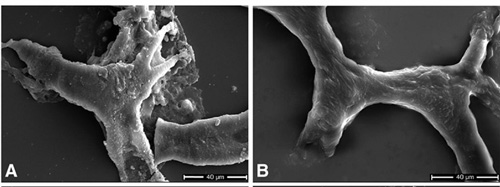 March 25, 2005
Dr. Mary Schweitzer, assistant professor of paleontology with a joint appointment at the N.C. Museum of Natural Sciences, has succeeded in isolating soft tissue from the femur of a 68-million-year-old dinosaur. Not only is the tissue largely intact, it's still transparent and pliable, and microscopic interior structures resembling blood vessels and even cells are still present.  Photo courtesy North Carolina State University
Schweitzer was interested in studying the microstructure and organic components of a dinosaur's bone. All bone is made up of a combination of protein (and other organic molecules) and minerals. In modern bone, removing the minerals leaves supple, soft organic materials that are much easier to work with in a lab. In contrast, fossilized bone is believed to be completely mineralized, meaning no organics are present. Attempting to dissolve the minerals from a piece of fossilized bone, so the theory goes, would merely dissolve the entire fossil. But the team was surprised by what actually happened when they removed the minerals from the T. rex femur fragment. The removal process left behind stretchy bone matrix material that, when examined microscopically, seemed to show blood vessels, osteocytes, or bone building cells, and other recognizable organic features. Since current data indicates that living birds are more closely related to dinosaurs than any other group, Schweitzer compared the findings from the T. rex with structures found in modern-day ostriches. In both samples, transparent branching blood vessels were present, and many of the small microstructures present in the T. rex sample displayed the same appearance as the blood and bone cells from the ostrich sample. Schweitzer then duplicated her findings with at least three other well-preserved dinosaur specimens, one 80-million-year-old hadrosaur and two 65-million-year-old tyrannosaurs. All of these specimens preserved vessels, cell-like structures, or flexible matrix that resembled bone collagen from modern specimens. Current theories about fossil preservation hold that organic molecules should not preserve beyond 100,000 years. Schweitzer hopes that further research will reveal exactly what the soft structures isolated from these bones are made of. Do they consist of the original cells, and if so, do the cells still contain genetic information? Her early studies of the material suggest that at least some fragments of the dinosaurs' original molecular material may still be present. "We may not really know as much about how fossils are preserved as we think," says Schweitzer. "Our preliminary research shows that antibodies that recognize collagen react to chemical extracts of this fossil bone. If further studies confirm this, we may have the potential to learn more not only about the dinosaurs themselves, but also about how and why they were preserved in the first place." The research was funded by NC State, the N.C. Museum of Natural Sciences and the National Science Foundation.
Source of News:
|